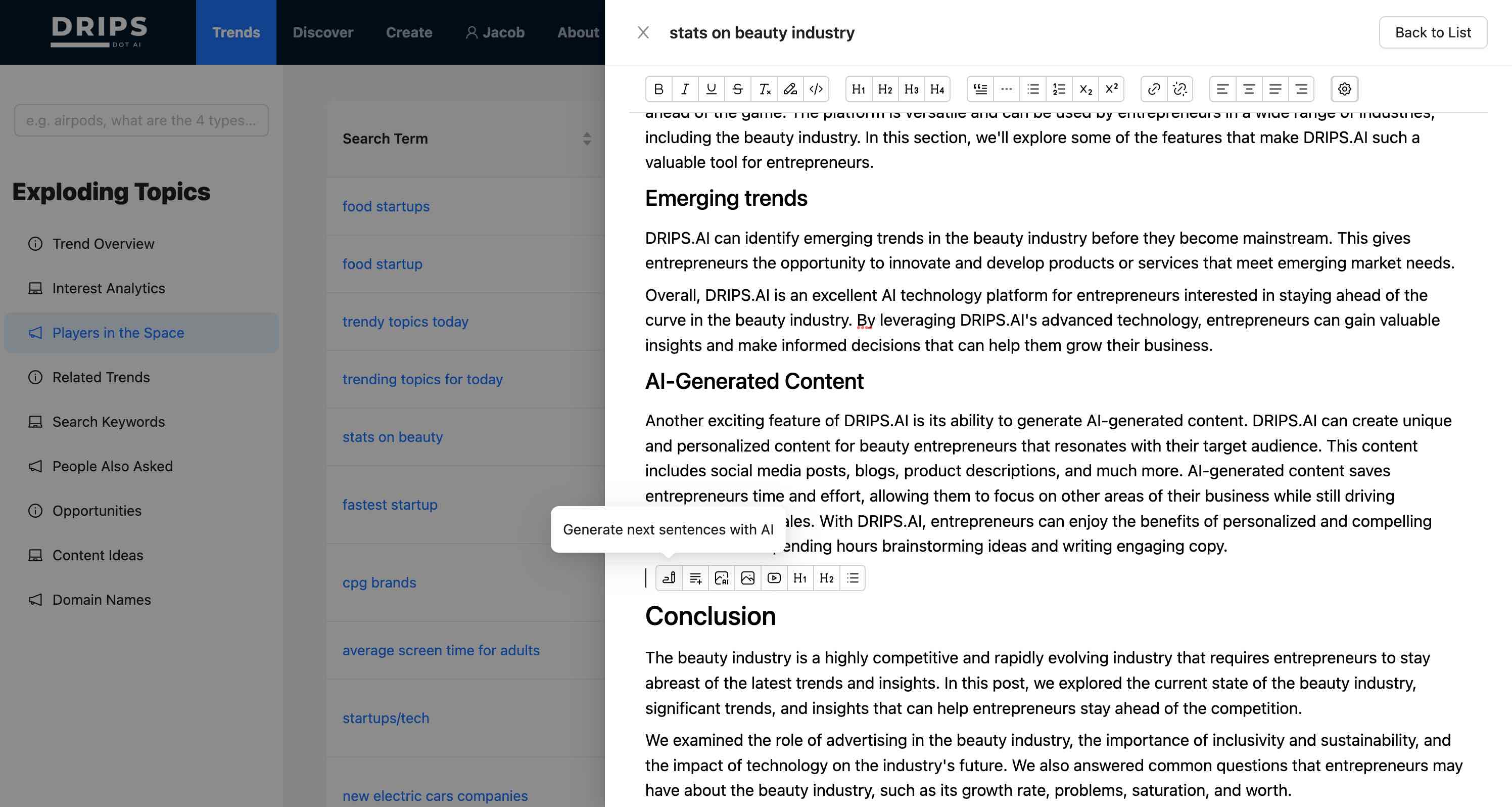What is an Automatic Writer?
By RG team · 13 min read
Last Updated on June 6, 2023
Wait a minute...

Introduction

Photo by Kelly Sikkema on Unsplash
As a content creator, the thought of producing a massive amount of content might seem daunting. Whether you're aiming to create blog posts, articles, or simply social media content, the pressure of coming up with an idea might take a toll on you. This is where an automatic writer comes in handy.
An automatic writer is a tool that uses artificial intelligence to generate unique and flawless content. This tool can produce articles, essays, research papers, and other content types with no human intervention. Autowriter.ai, Sassbook AI Writer, Rytr, Essaybot, Dr. Assignment Auto Writer, Magic Write, Smodin's Free AI Writer and Text Generator, Writesonic, and AI Writer are some of the most popular automatic writing tools currently available in the market.
In this article, we will dive deeper into the concept of automatic writing, how it works, and its benefits. We will also introduce the top automatic writing tools in the market, guide you on how to use them and share tips and tricks for maximizing the output. So, let's get started by defining what an automatic writer is.
What is an Automatic Writer?
An automatic writer is an AI-powered writing tool designed to speed up content writing for content creators. This tool can generate articles, essays, research papers, and various content types without human intervention. The concept of an automatic writer is often called "robo-journalism" or "robotic writing," where machines are used to do writing tasks that humans once did.
An automatic writer is different from human writers in many ways. Besides being faster, machines don't have feelings, thoughts, or biases like humans, so the output is usually objective. They also work 24/7, which means they can produce an endless amount of content in a short time.
However, it's important to note that automatic writers cannot replace human writers completely. Some content types, like creative writing, still require a human touch to make them more appealing. Moreover, machines can't improve their writing skills naturally like humans can due to natural learning. Instead, they rely on algorithms, data, trend analysis, and other forms of pattern recognition to generate content.
In the following section, we will explore how automatic writing works.
How Does Automatic Writing Work?

Photo by Olga Vilkha on Unsplash
Automatic writing works by using natural language processing (NLP) algorithms powered by machine learning. The algorithm takes a text-based prompt or topic and generates output based on learned patterns and data.
To generate content, an automatic writer uses various techniques such as paraphrasing, summarizing, and sentence structuring. As it generates content, it also analyzes other articles in the same topic and extracts data from them. The algorithm then uses this data to create unique content that covers the subject's various aspects.
One of the most popular techniques used in automatic writing is called generative pre-training transformer (GPT). GPT is an NLP technique that uses a neural network model called transformers to generate content. GPT has significantly improved recently, and it's now used in many automatic writing tools.
In the next section, we will explore the benefits of using automatic writing.
The Benefits of Using an Automatic Writer
Using an automatic writer comes with several benefits for content creators. Firstly, it saves time. Instead of spending hours researching a topic and writing an article, an automatic writer can do the same task within a short time. This helps content creators to focus on other important tasks or create more content.
Secondly, an automatic writer can generate high-quality content with no errors. Since it uses algorithms and data to generate content, mistakes are few and far between. This helps to minimize the editing time, ensuring that you can publish your content sooner.
Thirdly, an automatic writer can generate content on any topic. Whether you're an expert in the field or not, an automatic writer can generate content that accurately aligns with the topic's requirements.
Lastly, using an automatic writer can also improve your writing skills since you get to see how the algorithm structures sentences, uses vocabulary, and arranges paragraphs. You can learn from the algorithm and improve your writing skills.
In the next section, we will introduce the top automatic writing tools in the market.
Top Automatic Writing Tools in the Market
Several automatic writing tools are available in the market to help content creators generate unique, high-quality content. In this section, we will explore the top automatic writing tools and their features.
DRIPS.AI

Our platform operates by sifting through vast amounts of data, identifying emerging trends, the players within the trends, and new opportunities. Users can enter a brief description of their project, and drips.ai will provide relevant trend matches. This allows users to align their projects with growing market trends, enhancing their chances of success.
In addition to trend discovery, drips.ai also aids in content creation. Our platform leverages AI technology to assist in generating new articles, video scripts, and podcast scripts. With over 200 kinds of written tasks that you can tackle, you can be sure that you'll never run out of ideas.
Finally, our platform features a magical text editor. With a beautiful, simple interface, you can quickly and easily create content that is sure to capture your audience's attention. Our in-line features like image/video support, code blocks, and export to HTML mean that you can create rich, engaging content that is sure to impress.
Autowriter.ai
Autowriter.ai is an automated content writing assistant that uses AI to generate excellent-quality content within seconds. This tool also helps to conduct research, generates topic ideas, and checks for plagiarism.
Sassbook AI Writer
Sassbook AI Writer is a fast AI automatic text generation software that generates diverse content, from short to long-form content. Sassbook AI Writer is also easy to use, with a user-friendly interface.
Rytr
Rytr is an ideal tool for anyone who wants to write high-quality content in the shortest time possible. This tool can automatically generate content for various use-cases like blog ideas, articles, and essays.
Essaybot
Essaybot is an AI-powered essay writing assistant that can generate unique content for various topics. It also helps to generate research ideas, check for plagiarism, and give suggestions on grammar and spelling.
Dr. Assignment Auto Writer
Dr. Assignment Auto Writer is a writing assistant tool that helps to generate essays, research papers, or articles by entering a keyword or a topic.
Magic Write
Magic Write is an AI text generator and auto-rewriter that can quickly generate unique content in a short time. This tool also comes with a plagiarism checker to ensure that the content is unique.
Smodin's Free AI Writer and Text Generator
Smodin's Free AI Writer and Text Generator generate high-quality and unique essays and articles with just a few phrases.
Writesonic
Writesonic is an AI writer that helps marketers, writers, and bloggers to produce content for SEO, email marketing, and social media copy.
AI Writer
AI Writer is an AI text generator designed to help content creators generate natural-language content swiftly.
Choosing the right automatic writing tool depends on your business goals and budget. In the next section, we will discuss how to choose the right automatic writing tool for you.
Choosing the Right Automatic Writing Tool for You
Choosing the right automatic writing tool can be a daunting task, considering the many options available in the market. However, the following factors can help you make an informed decision.
Purpose
The first factor to consider when choosing an automatic writing tool is your content creation purpose. Does your content require in-depth research, or do you need help generating catchy headlines? Understanding your content goals will help you choose a tool that aligns with your needs.
Budget
The second factor to consider when choosing an automatic writing tool is your budget. Some automatic writing tools are free, while some require a subscription or a one-time fee. Having a budget in mind can help you choose a tool that's affordable and offers value for your money.
Experience Level
The third factor to consider when choosing an automatic writing tool is your experience level. Some tools are easy to use, while others require some technical expertise. If you're a beginner, it's advisable to start with a tool that's easy to use and gradually move to more advanced tools as you gain more experience.
Reviews
The fourth factor to consider when choosing an automatic writing tool is reviews. Check out reviews from other content creators who have used the tools before. Reviews can help you gauge the tool's credibility, strengths, and weaknesses.
In the next section, we will guide you on how to use an automatic writer.
How to Use Automatic Writer: Step-by-Step Guide
Using an automatic writer is easy, and the following steps will guide you on how to use one.
Step 1: Sign up for a Tool
The first step is signing up for an automatic writing tool that best suits your content needs. Once you have signed up, log in to your account and navigate to the appropriate section for generating content.
Step 2: Enter a Prompt or Topic
The second step is entering a topic or a prompt that you want to create content for. The prompt can be a title or a short description of what you want the content to be about.
Step 3: Select a Content Type
The third step is usually selecting the content type you want to create. Automatic writing tools can generate various content types, such as blog posts, essays, and research papers.
Step 4: Generate Content
After selecting the content type, you need to click Generate. The algorithm then starts analyzing your prompt and other articles in the same topic to generate content.
Step 5: Review and Edit
The last step is reviewing and editing your generated content. Editing helps to refine the content and give it a human touch. You can change the formatting, structure, and style to make the content more appealing to your target audience.
In the next section, we will share tips and tricks for successful automatic writing.
Tips and Tricks for Successful Automatic Writing

Automatic writing can be helpful for content creators, but its output quality varies depending on the tool used and the user's skill level. Here are some tips and tricks for successful automatic writing.
Understand the Prompt
Understanding the prompt or the topic helps the algorithm generate content that meets your needs. It's essential to have a clear topic in mind before using an automatic writing tool.
Use Simple Language
Automatic writing tools work by analyzing data and natural language patterns to generate content. Using simple, concise language can help the algorithm generate content that's easy to read and understand.
Edit Your Content
After generating content, it's essential to review and edit it before publishing. Editing ensures the content has the right tone, style, and structure, making it more appealing to your target audience.
Combine Automatic Writing with Human Writing
Combining automatic writing with human writing helps to maximize the content's quality and appeal. Automatic writing can help with researching and generating ideas, while human writing can add a personal touch to the content.
Practice Creativity
Automatic writing does not replace creativity, so it's essential to practice creativity when using an automatic writing tool. Use the generated content as a base and create appealing intros, conclusions, and subheadings that stand out to your target audience.
In the next section, we will share common misconceptions about automatic writing.
Common Misconceptions about Automatic Writing
Automatic writing is a relatively new concept that has gained popularity in recent years. However, the following are common misconceptions that people have about automatic writing.
Automatic Writing Replaces Human Writing
One of the common misconceptions about automatic writing is that it replaces human writing completely. Automatic writing tools can generate content, but they can't replace human creativity, style, and thought processes.
Automatic Writing is Expensive
Many people believe that automatic writing is expensive. However, many automatic writing tools are free or come with a low subscription fee, making them affordable for most content creators.
Automatic Writing Generates Low-Quality Content
Some people believe that automatic writing generates low-quality content. Automatic writing tools use algorithms, data, and NLP techniques to generate content that meets the topic's requirements. The output quality mostly depends on the tool used and the user's skill level.
Automatic Writing is Only for Non-Creative Topics
Another misconception is that automatic writing is only suitable for non-creative topics. Automatic writing can generate content for various topics, as long as the prompt or the topic is clear and straightforward.
In the next section, we will explore the future of automatic writing.
The Future of Automatic Writing
The demand for automatic writing tools has increased significantly over the years, and the market for such tools is expected to grow even more in the future. Here are some possible developments in automatic writing.
Enhanced Creativity
As automatic writing tools become more advanced, they will be more creative in generating content. They will be able to generate content that's more appealing and stands out to the target audiences.
Improved Efficiency
Efficiency in automatic writing is expected to improve with advancements in AI technology. As the algorithms become more refined, the time taken to generate content is expected to decrease significantly.
Increased Personalization
Automatic writing tools are already good at generating content for various topics. However, advancements in AI technology are expected to make them more personalized, taking into account the user's preferences and needs.
In-Depth Analysis and Insights
As automatic writing tools become more advanced, they will be able to provide analytics and insights into the generated content. This will help to improve content quality and tailor content to the target audience.
In conclusion, the future of automatic writing looks bright, and the technology is expected to improve significantly in the coming years. As a content creator, using an automatic writing tool can help you generate high-quality content faster and more efficiently.
Conclusion
In this article, we've explored the concept of automatic writing and its benefits for content creation. We've seen how automatic writing tools use AI technology to generate content on various topics quickly and efficiently.
We've also looked at some of the advantages of using automatic writing tools, including increased productivity, improved content quality, and reduced costs. Furthermore, we've discussed how automatic writing is expected to develop in the future, becoming more creative, personalized, and efficient. With these advancements, content creators will be able to generate high-quality content faster and more effectively, helping to meet the growing demands of the digital landscape.
In summary, automatic writing is a highly valuable tool for content creators, allowing them to save time and resources while generating high-quality content. As technology continues to evolve, the effectiveness of automatic writing tools is only expected to increase, making them an essential asset for content creators in the years to come.



